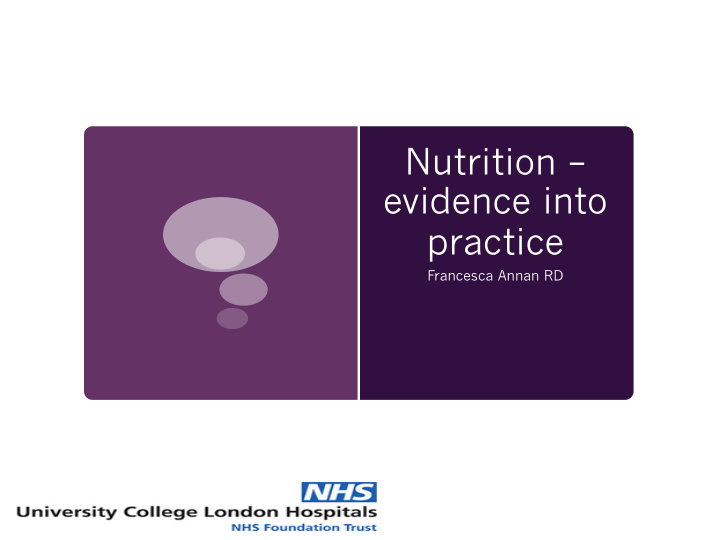



Nutrition – evidence into practice Francesca Annan RD
Evolving recommendations for management & care
Changes in nutrition recommendations ……… .
What do children and teenagers need to eat This bit isn’t about diabetes its all about growing!
UK recommendations for health § Energy recommendations to meet demands of growth § Vary with age, sex and activity level § E.g. 765kcal/day for a 1 year old boy compared to 1800kcal/d for a 10year old boy § Macronutrient recommendations § Protein, carbohydrate & fat § Vitamin and mineral DRVs § All vitamins, iron, calcium & more § Physical activity recommendations § 60 minutes MVPA a day
Food quality matters § Several studies which show that eating a diet which is higher in saturated fat, lower in wholegrain carbohydrates and vegetables and fruit = worse glycaemic management § This is true for both pen and pump § Quality matters
What does quality mean?
Protein § Protein provides essential amino acids for growth & development § Should be a mix of plant and animal sources § Protein content of meals will impact on blood glucose levels when eaten in very large serving sizes or relatively high protein of meal compared to carbohydrate content
How much protein makes a difference?
How much protein makes a difference § When 30g carbohydrate is consumed with 25g or more protein a blood glucose effect can be observed from 2hours.
How much food is that ……… Food Amount of protein 25g cheddar cheese 6g 2 eggs 12-16g 250ml milk 8g 150g Greek yogurt 11g 250g cooked pasta 10g 1 wholemeal pitta 6g 105g fillet steak 31g 120g cod 25g
Carbohydrate § Nutrient dense versus nutrient poor § Terms sugars and starches are not helpful § Not all carbohydrate is equal Wholegrain, low glycaemic index carbohydrate and legumes (peas, beans and lentils) are recommended and have been shown to improve glycaemic management
Glycaemic load § How a carbohydrate food affects BG depends on § Timing of insulin delivery (post meal insulin = 30% greater rise in BGL) § Amount of carbohydrate § Type of carbohydrate (Glycaemic index)
Food GI Portion Carb GL Lucozade 95 250ml 42g 40 Jelly 80 30g 28g 22 beans Milk 34 250ml 12g 4 Parsnip 52 80g 8g 4 Boiled 46 150g 32g 15 sweet potato King 75 150g 28g 21 Edward potato www.glycemicindex.org
Resistant starch …… § Cooking and cooling foods like rice and pasta changes BG responses § Different starch types digested at different speeds § Cooking, cooling and reheating changes starch types and therefore BG responses
How to reduce the GI of white rice § Cook § Cool for 24hours at 4 degrees § Reheat and eat
Fats § Saturated vs. Unsaturated § Mediterranean type diets = better for heart health § Saturated fat = insulin resistance § Higher fat meals need more insulin
Insulin to carbohydrate ratio § Covers some protein and fat § Meals of up to 30g carbohydrate with high protein load usually need increased insulin dose § Meals >30g carbohydrate with additional protein may not need additional insulin § Both protein and fat impact BG between 2 and 5hours § BG at 2hours post meal tells you about ratio § BG after 2hours tells you about meal composition
Calculating insulin doses for fat and protein § Dose increases of 40% or more = ñ increased risk of hypoglycaemia after 5hours § Increase insulin doses by calculating additional insulin for carbohydrate for example if meal is 50g carbohydrate and high in fat and protein increase by 5-15g carbohydrate to calculate dose § Pump – dual wave 60/40 § Pen – give extra insulin 1hour after eating § FPU studies all show increase in hypos – dose calculations usually increase insulin by 40-60%
Food changes that may help § Spread protein across the day including breakfast to blunt BG spikes § Eat more wholegrains, legumes and low GI/GL carbohydrate foods § Eat the right amount at the right time for growth and activity levels § Limit snacks between meals § Eat less added sugars and fewer high saturated fat meals
Lifestyle changes that help.. § Be active after meals – changes BG responses § Limit snacking § Limit screen time § Sleep routines
Food should also be fun …… Restricted eating patterns linked to increase in disordered eating behaviours
Questions Thank You
Recommend
More recommend